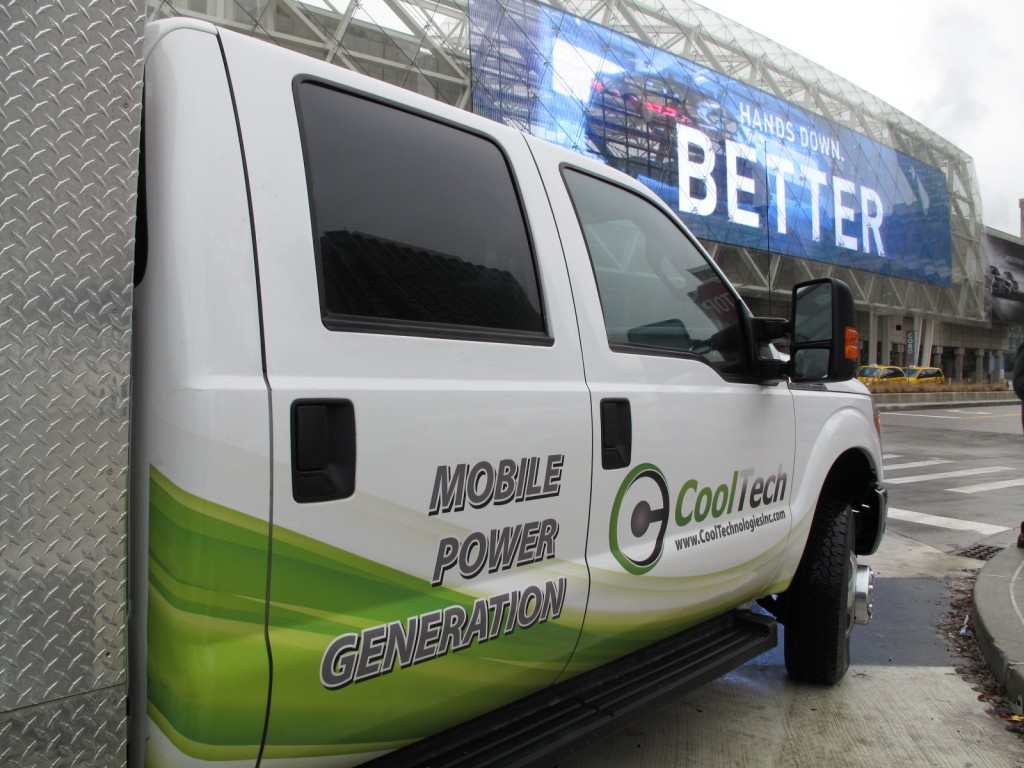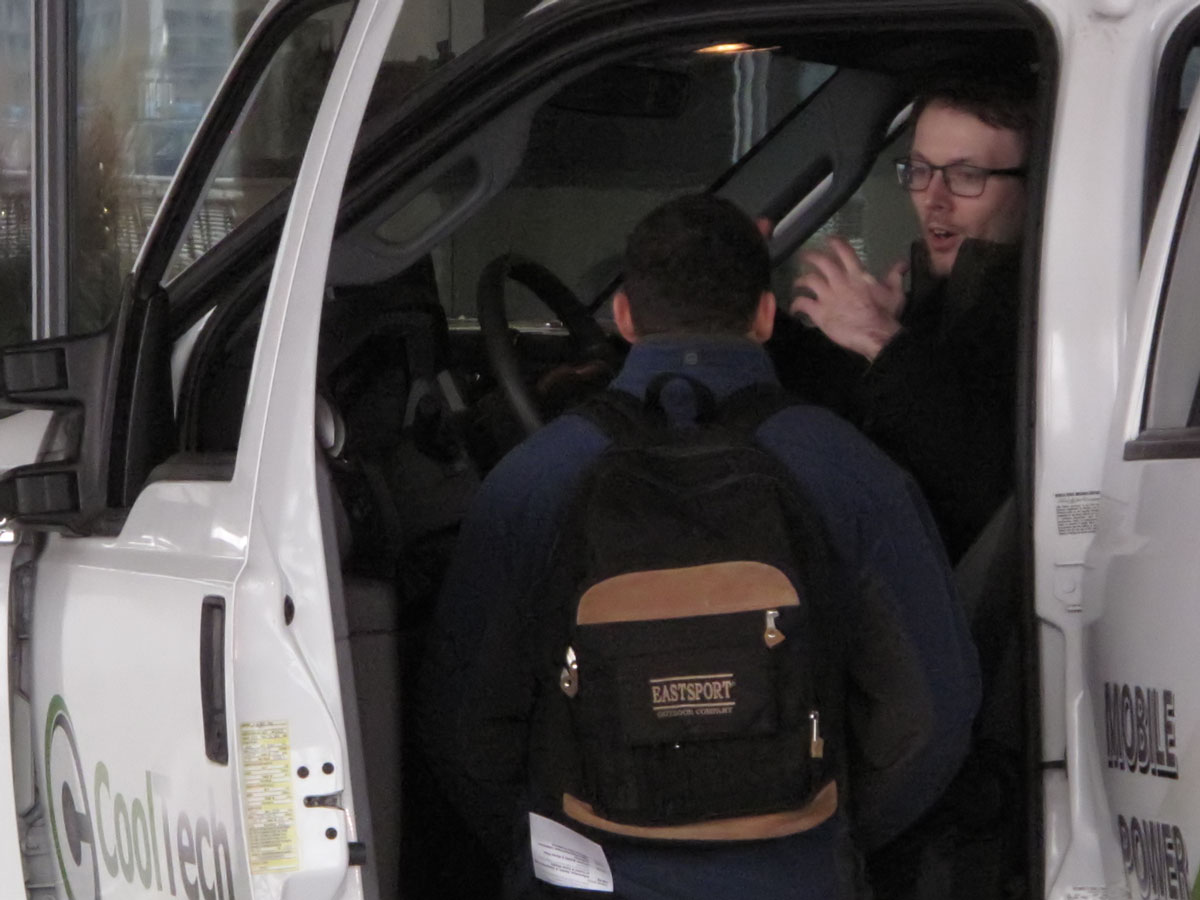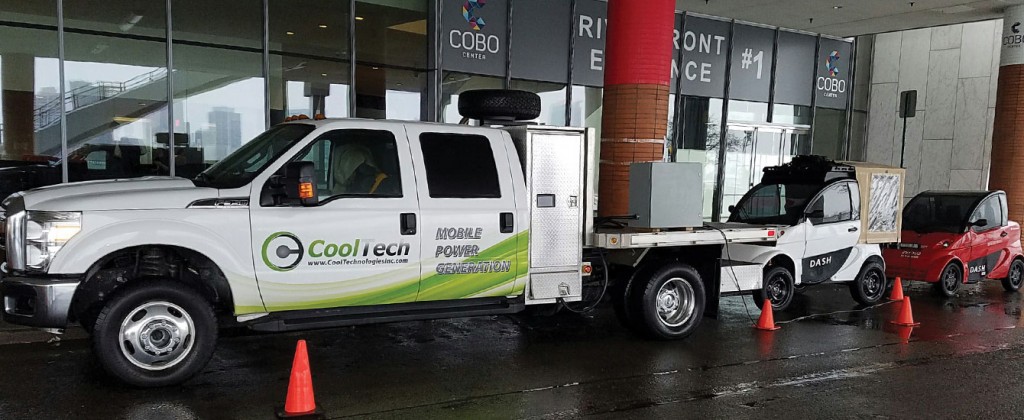Cool Technologies premiered its 30 kVA MG system to the media and industry professionals at the North American International Auto Show in Detroit on January 9-12, 2017.
Everything the company has promised was demonstrated for four days: every capability, every benefit, every unique element. Viewers and participants were able to inspect start-up procedures, system operation, shut down and normal driving mode. Many commented favorably on the simple intuitive design of the Human Machine Interface, with its interactive checklists and safety features. Most importantly, whenever an electric vehicle or vehicles needed charging, the MG delivered.
Consequently, we are pleased to report the show was a success. Interest was sparked, feelers extended and business cards exchanged. We are working through opportunities that were presented either at the show or in follow-up calls including an offer to represent and distribute the MG system.
Expect more public demonstrations soon at trade shows and large sporting events.
Here are a few takeaways:
- No other company provided mobile charging services nor offered comparable technology at the show.
- Our mobile charging solutions address range anxiety for EV owners, those who rent or lease vehicles and even those who provide autonomous vehicle services.
- Level II charging is available now. Later this year, we will offer a Level III DC mobile fast charge with our under-chassis technology.
- What does our appearance at the show mean for shareholders and investors? We have a viable, manufacturable product and we are prepared to take pre-orders for Ford F350’s, 450’s and 550’s now. Contact Tim Hassett at 813 975-7467 for more information and pricing.
As for the rest of the show …
With the exception of concept cars, few companies offered radically new exterior designs, the focus, instead, was on the technology inside. Connectivity, mobility, and battery power were common buzz words. As a result, autonomous and electric vehicles were an essential part of the show. Ford, Chevy, Chrysler, Mercedes, VW, Toyota, Nissan, VW, Jaguar and Chrysler all offered EVs.
Ford’s offering was hardly unexpected. In 2015, the company committed $4.5 billion to developing 13 hybrid or electric vehicles by 2020, including a 300-mile electric SUV, and hybrid versions of the Mustang and F-150 pickup.
According to Crains,
By 2020:
- Tesla plans to sell 1 million EVs globally.
- Volkswagen expect to sell 2 to 3 million EV’s annually.
- Nissan predicts 20% of in sales in Europe.
- Ford forecasts that EVs will account for 15 to 20% of the Chinese market.
By 2025:
- Mercedes predicts 15 to 25% of the vehicles it sells globally will be powered by batteries.
- BMW has said the same but includes hybrids.
- Ford anticipates that 25% of all vehicles sold globally will get all or some of their power from a plug.
With the change of administrations, the future of electric vehicles in the US is murky. Despite aggressive new fuel standards from the Obama administration as well as state and federal rebates for electric vehicle purchases and conversions, the EV market suffered small declines in 2015 and 2016 as cheap fuel drove demand for gas-guzzlers such as pickups and SUVs. Plus, the Trump administration may rescind or reduce the 2025 fuel standards.
However, according to an article from Reuters by Laurence Frost, hitting the brakes on electric vehicle development in the US would not relieve the pressure to bring them to market. China and Europe are forging ahead with policies to expand sales of plug-in vehicles which should leave global carmakers and consumers with little choice but to embrace plug-in vehicles. As a result, Industry execs believe electric vehicles will gain momentum in 2017 and fuel an investment surge.
As quoted by Reuters, “Car electrification is an irreversible trend,” said Jacques Aschenbroich, chief executive of auto supplier Valeo, which has expanded sales by 50 percent in five years with a focus on electric, hybrid, connected and self-driving cars.
That is why Ford is still moving ahead with its $4.5 billion investment in plug-in vehicles.
Chief Executive Mark Fields was quoted in the Reuters article as saying, “The industry is changing, the infrastructure’s starting to build, and that’s why our view is (that) within the next 15 years we’ll see more electrified offerings than we’ll see gasoline-powered.”
On a regional and local level,, states such as California continue to push ahead with quotas for electric or other zero emission vehicles. Cities such as Columbus, Ohio are preparing for the first larger scale tests of connected electric vehicles on public roads later this year. Universities are experimenting with electric vehicle ride sharing on campus. Others are testing last mile riding sharing connections from mass transition stations to corporate parks using EVs.
With all that in mind, members of the media and industry professionals went to the Delphi Automotive Test Track by the Cobo Center each day to drive a number of electric vehicles. Keeping them charged was a Cool Tech 30 kVA MG System.





